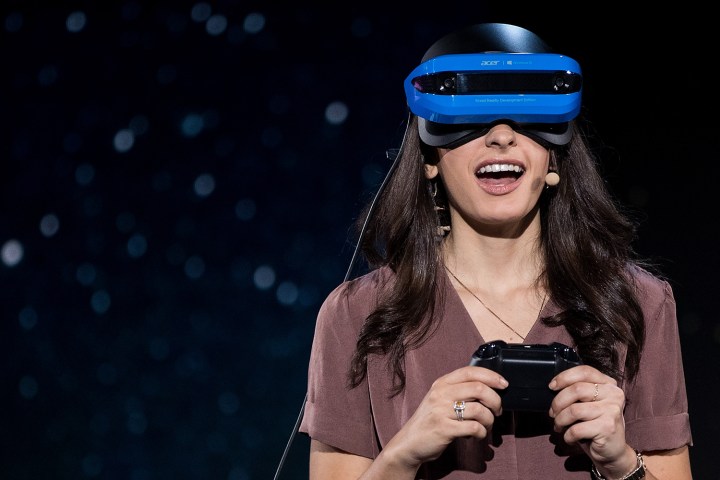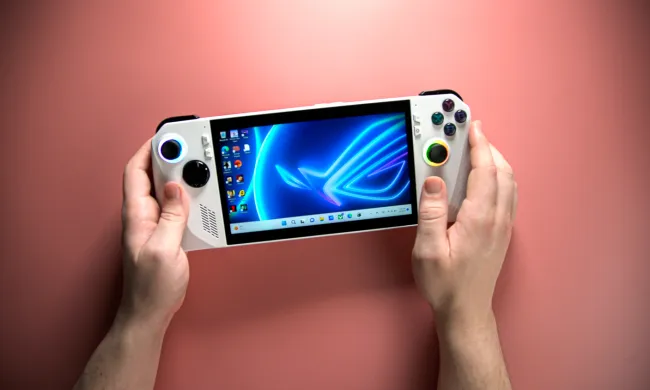
Microsoft sells a Development Edition of the Hololens today for $3,000, which is a neat product, but not something for you or me. We probably aren’t building apps or figuring out how to incorporate mixed reality environments into our company’s workspace. We want to play games, explore new environments, and interact with our friends and colleagues in new ways.
For you and me, there’s Windows Mixed Reality.
No external gizmos required. These headsets can map a play space using the headset’s cameras.
Microsoft set up shop in the top floors of its Fifth Avenue retail facility to showcase a variety of headsets under that tagline from partners such as HP, Lenovo, Acer, and Dell. (Dell released details on the Dell Visor headset Monday morning.) Mixed Reality headsets are low-cost goggles you strap around your head just like an Oculus Rift or HTC Vive or Samsung Gear VR, and they run a special Windows environment optimized for virtual reality. The lineup will go on sale this fall, with headset and motion control bundles starting at $400. Those will work best with more-powerful computers featuring discrete graphics chips; systems that work with integrated graphics chips, and contain slightly more processing power of their own, will go for $500.
If you think that sounds a lot like the premise of those other VR headsets, give yourself a gold star. Everyone in technology thinks virtual reality or augmented reality (or some mixture of the two – hence the name) will transform the world of computing. Microsoft’s efforts are broader than what you’ll find in today’s best VR headsets, considering the company’s first-mover lead in the AR space, but the new line of products primarily caters to what consumers want now: games. After all, gaming is the primary reason people buy VR headsets today.
Windows Mixed Reality systems aim to address many of the pain points with current systems. No external gizmos are required, as these headsets can map a play space using the headset’s cameras. They also don’t require third-party applications. The compatible Windows Mixed Reality software is built right into Windows 10.
I was blown away when I first tried on HoloLens. Would Mixed Reality prove as cool?
Slipping into mixed reality
On a steamy New York summer in a not so well-ventilated store, I stepped into a back room and fitted an Acer headset over my head. It looks and feels exactly as you’d imagine — picture blue ski goggles with rigid plastic rather than stretchy rubber bands around your head. A foam pad surrounds the eyepiece (I could feel “Oculus Face” setting in) and a dial at the back tightens to hold it to your head. The system can be put on by one person, but a perhaps overly cautious Microsoft employee insisted on helping me, tightening the dial through a series of clicks until it was comfortable. Well … somewhat comfortable.

The Acer headset felt heavier than the Playstation VR and less secure than the Rift, which you can dance in without having it slip off. The weight of the Acer system was a pressure on my nose and cheekbones that I wanted to relieve by adjusting the placement on my head, though honestly, overall it wasn’t too disconcerting. It was just very much there. A cord ran off the headset on the left side, which irritated my ear a bit, and connected the system to a laptop.
The system slipped over my eyeglasses comfortably, and once on my head, I didn’t give a second thought to my lenses. Almost every VR headset claims to be compatible with glasses, but most fail when you try it. Of course, your results will vary, depending on the size of your frames.
Overall, the Acer headset felt no better or worse than other headsets I’ve worn, and it doesn’t solve a fundamental issue of virtual reality. I don’t want to hang out in ski goggles. No one does.
Hand controllers are optional, and give you a way to interact with the world around you, as well as the built-in head tracking. Microsoft’s controllers look a lot like Oculus Touch: a molded plastic grip, triggers at your pointer fingers, a touchpad and a wand for each thumb. A “home” button lives under the ball of your thumb to get you out of an application and back to the main environment, though it lacked a dot or raised button to let you know where it was. Details, details. Still, once your thumb knows to go for it, you can find it.

Microsoft says its headset works just fine connected to an ordinary laptop. To test that, I wore the system when connected to a high end Razer Blade Pro (2017), a notebook PC with discreet graphics, and a more mainstream HP Spectre x360 13, a notebook PC with integrated graphics. The headset never lagged or stuttered during either demo.
Virtual reality? Windows has an app for that
Windows 10 has evolved with the Creators Update, but at heart it’s still based around the same 2D desktop metaphor as Windows 3.1. The same holds true for Apple’s MacOS 10 High Sierra. A 3D interface requires a new metaphor, so Microsoft has built a virtual house environment for you in its mixed reality space. You use the thumbstick to look around, and the thumbpad to jump forward to a different location. Or maybe it’s the other way around? I kept getting confused, but I only had half an hour or so with the headset; after a little use movement became second nature.

Within the various rooms of your virtual house, floating movie screens hang like pictures on the wall, and are used to access programs. Since Microsoft is focused on gaming at launch, the company filled my demo house with a variety of game demos. You can imagine how HP would build a house with a window to tech support, or Dell would build an out-of-the-box experience with a link to its software store. It’s a far more fleshed out and robust environment than that I’ve seen in other VR systems, though I didn’t have as much time to explore it as I would have liked.
But back to the games! I tried several titles that were exactly as immersive and wonderful as those you’ve tried or read about from other platforms. Standing before one of the hanging windows, I clicked a button to enter the app it stood for, and a virtual reality world leapt up to surround me: Space Pirate Trainer. Using one controller as a lasso to rope in alien invaders, I picked them off like an ace.
I also tried Arizona Sunshine, where I blew up shambling zombies with a six-shooter in the Wild West. Using the hand controllers, I picked up cartridges and an ammo belt, and found myself reloading and killing like a professional zombie hunter. I even fought off assailants in Superhot by throwing ninja stars at them, just as is possible with the Oculus Rift and HTC Vive.
Then there’s the grand-daddy of the space: Minecraft. Minecraft in VR is vastly superior to the desktop version. After building a 3D world you can explore it, leaping from block to block like a gazelle. Using the thumbstick to look around, I found a likely spot, and hit the thumbpad to jump there.
The hand controls were intuitive in all the games I tried, and the system was robust, though admittedly still a little buggy. One or two games crashed, although they reloaded almost instantly at the push of a button. I also found myself frequently pushing the wrong button on the controller and zapping out of the game environment, which was frustrating.
A few paragraphs ago, I wrote that gaming was “as immersive and wonderful” as on other platforms, and that’s both a pro and a con. Sure, it’s great that Microsoft can equal what’s already available, through partnerships like one announced this morning with Steam. But all those games are already available elsewhere. That leaves Windows Mixed Reality without a much-needed killer app.
The VR/AR competition goes bonkers
As Microsoft has developed its platform, the world around it has evolved. What seemed groundbreaking two and half years ago is still impressive, but in that time virtual reality has exploded, and is becoming very complex. Windows Mixed Reality will have plenty of competitors.
Google said at its I/O conference in May that it plans to launch a whole array of standalone virtual reality headsets which won’t require a separate phone. Samsung has the exact same plan, something the company calls “Odyssey.” And there’s the looming threat of Apple’s ARkit, which turns an ordinary iPhone into an augmented reality marvel.
People want more affordable, more intuitive VR, and Windows Mixed Reality will bring it.
Microsoft’s advantage is supposed to be in augmented reality, given the head start HoloLens gave the company. Yet, based on the demo Microsoft gave me, I couldn’t tell how AR fits into the whole system, which is very much designed for virtual reality. So far, Windows Mixed Reality appears to be virtual reality with a different name. So I asked Microsoft where the AR was.
“We believe that mixed reality represents a spectrum spanning everything in between full physical reality and full digital or virtual reality,” a spokeswoman told me. “While the upcoming Windows Mixed Reality headsets are closer to the full digital end of the spectrum, they do begin to incorporate elements of the physical world, such as environmental awareness and full [six degrees of freedom] hand input via motion controllers.”
Two and a half years ago, I saw the future. An electrician remotely helped me rewire a light switch, drawing on the wall before my eyes to show me which wires to touch and which to stay away from. That’s the real power of AR, and it makes tremendous sense.
Microsoft’s Mixed Reality headsets don’t show that side of the equation just yet. They instead focus on a more convenient, slightly less expensive alternative to current virtual reality headsets. That falls short of the vision originally promised – but it may still be enough to move VR forward. People want more affordable, more intuitive VR, and Windows Mixed Reality will bring it.


